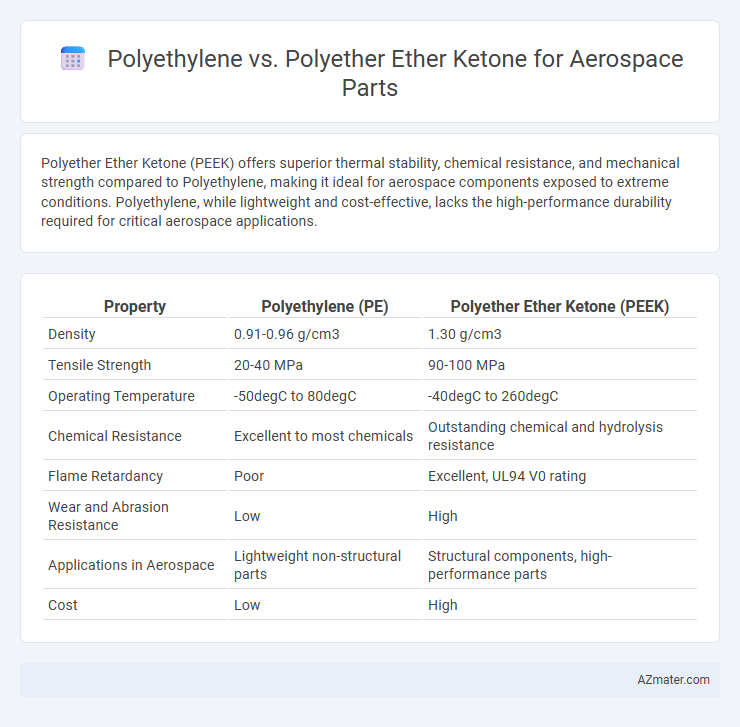Polyether Ether Ketone (PEEK) offers superior thermal stability, chemical resistance, and mechanical strength compared to Polyethylene, making it ideal for aerospace components exposed to extreme conditions. Polyethylene, while lightweight and cost-effective, lacks the high-performance durability required for critical aerospace applications.
Table of Comparison
| Property | Polyethylene (PE) | Polyether Ether Ketone (PEEK) |
|---|---|---|
| Density | 0.91-0.96 g/cm3 | 1.30 g/cm3 |
| Tensile Strength | 20-40 MPa | 90-100 MPa |
| Operating Temperature | -50degC to 80degC | -40degC to 260degC |
| Chemical Resistance | Excellent to most chemicals | Outstanding chemical and hydrolysis resistance |
| Flame Retardancy | Poor | Excellent, UL94 V0 rating |
| Wear and Abrasion Resistance | Low | High |
| Applications in Aerospace | Lightweight non-structural parts | Structural components, high-performance parts |
| Cost | Low | High |
Introduction to Aerospace Polymers
Polyethylene and Polyether Ether Ketone (PEEK) are key aerospace polymers, with PEEK offering superior thermal stability, chemical resistance, and mechanical strength essential for high-performance aerospace parts. Polyethylene is valued for its lightweight and flexibility but is generally limited to low-stress, non-structural components due to lower melting points and mechanical properties. Advanced aerospace applications increasingly favor PEEK for critical components requiring durability in extreme environments, enhancing overall aircraft performance and safety.
Overview of Polyethylene (PE)
Polyethylene (PE) is a versatile thermoplastic polymer known for its excellent chemical resistance, low density, and impact strength, making it suitable for lightweight aerospace components. Its ease of processing and cost-effectiveness contribute to its widespread use in non-structural aerospace parts such as insulation, seals, and liners. Despite lower thermal stability compared to Polyether Ether Ketone (PEEK), PE's moisture resistance and flexibility provide functional advantages in various aerospace applications.
Overview of Polyether Ether Ketone (PEEK)
Polyether Ether Ketone (PEEK) is a high-performance thermoplastic known for its exceptional mechanical strength, chemical resistance, and thermal stability, making it ideal for aerospace components exposed to extreme conditions. Its high melting point around 343degC and superior wear resistance enable prolonged service life in demanding aerospace environments. Compared to polyethylene, PEEK offers significantly enhanced structural integrity and durability, critical for aerospace parts requiring high precision and reliability.
Material Properties Comparison: PE vs PEEK
Polyether Ether Ketone (PEEK) exhibits superior mechanical strength, thermal stability up to 250degC, and chemical resistance compared to Polyethylene (PE), making it ideal for aerospace components exposed to extreme environments. Polyethylene offers lower density and cost, with good impact resistance but limited temperature tolerance around 80-100degC. The high tensile strength and wear resistance of PEEK outperform PE, providing enhanced durability essential for critical aerospace applications.
Mechanical Strength and Performance
Polyether Ether Ketone (PEEK) exhibits superior mechanical strength and thermal stability compared to Polyethylene (PE), making it more suitable for aerospace components subjected to high stress and extreme temperatures. PEEK's tensile strength ranges from 90 to 100 MPa and maintains integrity beyond 250degC, whereas Polyethylene typically offers tensile strength below 40 MPa and degrades at lower temperatures around 80degC. The enhanced fatigue resistance and chemical inertness of PEEK contribute to its preferred use in critical aerospace parts requiring long-term durability and performance under harsh environmental conditions.
Thermal Resistance and Stability
Polyether Ether Ketone (PEEK) exhibits superior thermal resistance compared to Polyethylene, withstanding continuous use temperatures up to 250degC, whereas Polyethylene typically deforms above 80-100degC. PEEK maintains exceptional dimensional stability and mechanical properties under thermal stress, making it more suitable for aerospace parts exposed to extreme temperature variations. In contrast, Polyethylene's lower thermal stability limits its application in high-temperature aerospace environments where performance reliability is critical.
Chemical Resistance and Environmental Durability
Polyether Ether Ketone (PEEK) exhibits superior chemical resistance compared to Polyethylene (PE), effectively withstanding aggressive solvents, acids, and high-temperature oxidation prevalent in aerospace environments. PEEK maintains mechanical integrity and dimensional stability under extreme thermal cycling and UV exposure, outperforming Polyethylene, which is prone to chemical degradation and environmental stress cracking. The exceptional environmental durability of PEEK, including resistance to hydrolysis and radiation, makes it the preferred polymer for aerospace parts requiring long-term reliability and minimal maintenance.
Weight and Density Considerations
Polyethylene offers a lower density of approximately 0.95 g/cm3, making it a lightweight option for aerospace parts where weight reduction is critical. Polyether Ether Ketone (PEEK), with a higher density around 1.3 g/cm3, provides superior mechanical strength and thermal stability, essential for high-performance aerospace applications. Balancing weight and density, polyethylene is suitable for non-structural components, while PEEK is preferred for load-bearing parts requiring durability under extreme conditions.
Cost-Effectiveness in Aerospace Applications
Polyethylene offers significantly lower material costs compared to Polyether Ether Ketone (PEEK), making it a budget-friendly option for non-critical aerospace components. PEEK provides superior thermal stability, chemical resistance, and mechanical strength but at a considerably higher price, justified in high-performance aerospace parts subjected to extreme conditions. Cost-effectiveness depends on the specific application demands, with polyethylene suited for cost-sensitive, low-stress parts while PEEK is preferred where durability and reliability override initial material cost concerns.
Conclusion: Selecting the Optimal Polymer for Aerospace Parts
Polyether Ether Ketone (PEEK) outperforms Polyethylene in aerospace applications due to its superior thermal stability, mechanical strength, and chemical resistance, essential for high-performance environments. PEEK's ability to withstand continuous use at temperatures up to 250degC and resist wear under extreme conditions makes it the preferred polymer for critical aerospace components. Polyethylene, while cost-effective and lightweight, lacks the durability and heat resistance required for advanced aerospace parts, limiting its application to less demanding structural elements.

Infographic: Polyethylene vs Polyether Ether Ketone for Aerospace Part
 azmater.com
azmater.com